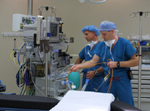Main OR holds grand opening
Renovating the main operating suite has been, and is, a long process. But the end is in sight.While September is the latest estimate for completion down to the last detail, a grand opening for the finished areas was held March 18.
 Andy
Lisicki, clinical engineer for anesthesia, left, and John Holter, anesthesia
administrative coordinator, prepare one of the operating rooms for the
main operating suite's Grand Opening, Monday, March 18.
Andy
Lisicki, clinical engineer for anesthesia, left, and John Holter, anesthesia
administrative coordinator, prepare one of the operating rooms for the
main operating suite's Grand Opening, Monday, March 18.
The renovation has included the surgery waiting room, PACU (recovery room), adult holding, pediatric holding, ORs 21 and 22, 1 and 2, and the new ORs, 3 and 8, and newly constructed rooms 14, 15, 16, 17, 18, and 19.
The male and female locker rooms and a classroom are still under construction as well as the floors in the remaining ORs and hallways.
The construction began last June.
At the completion of this phase there will be 21 operating rooms, a 21-bay PACU, a 13-suite adult holding room, and a six-bay pediatric holding room. There will also be new locker rooms and a new classroom.
The new ORs are state-of-the-art. They have equipment booms in each room that will hold laparoscopic equipment, cautery machines, headlights, and other equipment needed for surgery. The goal is to have everything off the floors for safety and ease of use for the staff.
The rooms are ergonomic and were designed with input from the staff. The outlets and computer plugs and other outlets are all at chest level. The physicians wanted a digital and analog clock because the digital clocks are harder to see. The anesthesia staff wanted the gases on the booms for ease and future use.
Perfusion gases were placed on the booms for closer proximity and also to alleviate the cords being on the floors. There was incredible planning on everyone’s part to design the rooms for ease of use.
There will be flat screen monitors on three of the booms to display the hemodynamic monitoring, the endoscopic image, the camera image from the OR light and microscope image. In addition one of the monitors will display the PACS image for the surgeon to view at the operative field.
There are three workstations with phones in each OR. One for the physician, one for anesthesia and one for the circulating nurse. In the next several months Pyxis, an automated distribution system for medical/surgical supplies should be implemented in the OR to help locate supplies and capture charges for surgical, anesthesia, and perfusion supplies.
The goal for this project was to make the work environment user friendly
for the entire staff of the operating room.